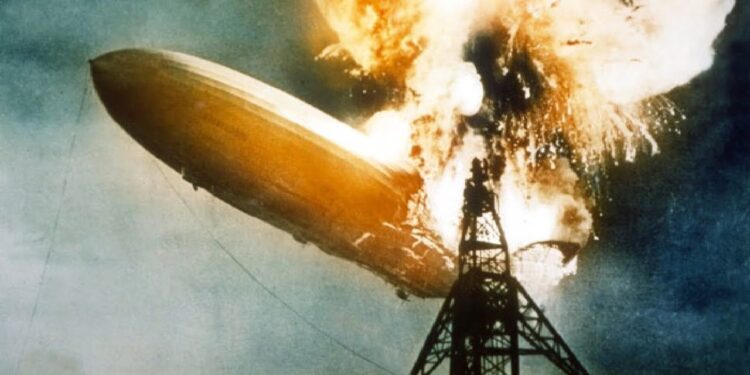On May 6, 1937, the sky above Lakehurst, New Jersey became the backdrop for one of history’s most infamous aviation disasters. The German passenger airship LZ 129 Hindenburg, pride of the Nazi regime and marvel of modern engineering, erupted into flames while attempting to dock at the Naval Air Station. Within seconds, the largest aircraft ever built was consumed by fire, plummeting to the ground as horrified spectators watched. The disaster, which claimed 36 lives, was captured on film and radio, making it one of the first major catastrophes to be documented in real time for a global audience.
The Airship Era
The Hindenburg represented the pinnacle of airship technology in an era when these lighter-than-air craft were considered the future of luxury air travel. At 804 feet long—nearly the length of three football fields—the Hindenburg was a floating palace of unprecedented size and comfort. Passengers enjoyed elegant dining rooms, comfortable sleeping quarters, a writing room, lounge, and even a smoking room (ironically equipped with special safety features).
Designed and built by the Zeppelin Company in Germany, the Hindenburg made its maiden voyage in March 1936. It completed 63 successful flights, including 36 transatlantic journeys, before its fatal final flight. The airship offered a level of luxury and comfort unmatched by the primitive airplanes of the day, crossing the Atlantic in about 60 hours—roughly half the time of the fastest ocean liners.
The Final Flight
The Hindenburg departed Frankfurt, Germany on May 3, 1937, for its first transatlantic crossing of the season with 97 people aboard—61 crew members and 36 passengers. After a journey delayed by headwinds, the airship arrived at Lakehurst on the afternoon of May 6.
Due to thunderstorms in the area, Captain Max Pruss circled for several hours waiting for conditions to improve. Around 7:00 PM, the crew received clearance to land. Spectators, journalists, and photographers gathered at the landing field to witness the magnificent airship’s arrival.
The Disaster
At 7:25 PM, as the Hindenburg approached its mooring mast and dropped its landing lines, witnesses observed what appeared to be a small flame near the tail section. Within seconds, the hydrogen that provided the craft’s buoyancy ignited, engulfing the entire airship in flames.
Radio announcer Herbert Morrison, broadcasting the landing for WLS Chicago, delivered what would become one of the most famous news reports in history, crying out in horror: “Oh, the humanity!” as the burning airship crashed to the ground.
The entire disaster unfolded with shocking speed—from first flame to complete destruction took only 34 seconds. Remarkably, 62 of the 97 people on board survived, though many suffered severe burns. The toll might have been much higher had the ship been at a greater altitude when the fire began.
Causes and Investigation
The exact cause of the disaster remains debated even today. The official investigation by the United States Commerce Department determined that a hydrogen leak was ignited by static electricity, possibly created by the wet mooring ropes dragging on the ground during landing.
Other theories have emerged over the decades:
- A lightning strike
- Sabotage (though no evidence was ever found)
- Flammable skin treatment on the airship’s outer covering
- St. Elmo’s fire igniting leaking hydrogen
Modern analysis tends to favor the static electricity theory, with the airship’s outer covering (treated with materials containing aluminum and iron oxide—components similar to rocket fuel) contributing to the rapid spread of the flames.
Historical Impact
The Hindenburg disaster effectively ended the era of passenger airships. While airships had experienced accidents before, the graphic nature of the tragedy, captured on film and broadcast worldwide, destroyed public confidence in airship travel. Within days, the sister ship of the Hindenburg, the Graf Zeppelin, was grounded, and commercial airship travel never recovered.
The tragedy accelerated the shift toward heavier-than-air aircraft for passenger transportation. By the outbreak of World War II just two years later, airplanes had begun to establish their dominance in long-distance air travel.
Cultural Legacy
Few disasters have been seared into public consciousness like the Hindenburg. The haunting images and film footage of the burning airship have become iconic symbols of technological disaster. Herbert Morrison’s emotional radio broadcast remains one of the most recognizable audio recordings of the 20th century.
The phrase “Oh, the humanity!”—Morrison’s spontaneous cry of anguish—has entered the lexicon as an expression of dismay at tragic events. The disaster has inspired countless books, films, songs, and other cultural references, including Led Zeppelin’s debut album cover, which featured an image of the burning airship.
The Hindenburg disaster stands as a pivotal moment in aviation history—the spectacular end of the airship era and a stark reminder of both the marvels and dangers of technological innovation. While lighter-than-air craft continue to fly today in the form of blimps and modern airships, they never again carried passengers on regularly scheduled transcontinental journeys.
As with many famous disasters, the Hindenburg’s legacy transcends its immediate impact. It serves as a cautionary tale about the risks of new technologies, the importance of safety in transportation design, and the power of media to shape public perception. Nearly a century later, those 34 seconds of destruction remain one of history’s most vivid reminders of how quickly triumph can turn to tragedy.
newshub


Recent Comments